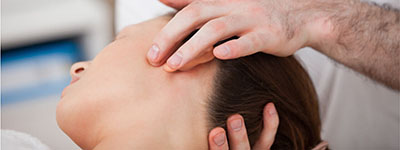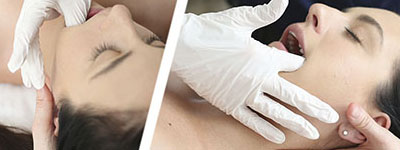TEMPOROMANDIBULAR JOINT THERAPY (TMJ)
Massage That Addresses Tension in the Jaw, Face, & Neck
Massage therapy may offer some relief for people with temporomandibular joint disorder (a condition commonly referred to as TMJ syndrome or TMJ). Marked by pain and stiffness in the jaw, face, and neck, TMJ affects the temporomandibular joint, which connects your jaw to the side of your skull. By using massage on the muscles surrounding the temporomandibular joint, TMJ clients may be able to lessen pain and ease TMJ symptoms.
What Is TMJ Massage?
TMJ Massage is used to treat inflammation and soreness in the temporomandibular joint. The temporomandibular joint connects the lower jawbone to the rest of the skull, and while they might not be addressed as much as other muscles in the body, they play a vital role in your day-to-day routine.
This is why TMJ disorders can be so debilitating. Your jaw gets utilized whenever you open your mouth to eat, drink, or speak. Chronic TMJ pain can make it difficult to hold a casual conversation or chew solid food, giving the condition an outsized impact on your quality of life. Your health suffers when it hurts to have a balanced meal.
Causes of TMJ Disorder:
The cause of a TMJ disorder varies with the individual. Some people are dealing with arthritis or the lingering aftereffects of a prior injury. For others, the symptoms are stress related, especially when that stress is paired with repetitive behaviours like grinding and gnashing of the teeth. Regular clenching can create severe tension that often gets worse if the issue is not addressed over time.
Intra Oral Massage:
Intra oral massage is not the first thing you think of when going to a massage therapist, but it can be very beneficial with reducing some of those stress related TMJ issues. Stress can lead to increased muscle tone and trigger points within the muscle of mastication (chewing) thus causing clenching, grinding, clicking of the jaw, limited opening, headaches, ear pain and even tooth pain. By receiving intra-oral massage, one can start to get relief from these symptoms in a few short treatments.
What To Expect in a Typical TMJ Treatment:
- A typical TMJ treatment begins with full treatment of the upper back, neck and shoulders to reduce tension in these areas and to help the jaw relax fully. Certain muscles within the head and jaw react to positional changes in the neck and spine. Having an imbalance in an area below can cause the jaw to over correct in trying to re balance the body.
- Next work is done extra orally to get an understanding of the structures and a further look on how the jaw is moving.
- Finally, a glove is used and your therapist works intra-orally on the muscle of the jaw, this is done within your comfort level.
- Following treatment, you will have a sense of looseness within the jaw and should have some decrease in symptoms. Self-massage is a great piece of home care that the client is able to do when they notice symptoms starting to reoccur.

TMJ Massage is used to treat inflammation and soreness in the temporomandibular joint, which connects your jaw to the side of your skull.

A typical TMJ treatment begins with full treatment of the upper back, neck and shoulders to reduce tension in these areas and to help the jaw relax fully.

TMJ Massage is used to treat inflammation and soreness in the temporomandibular joint, which connects your jaw to the side of your skull.
